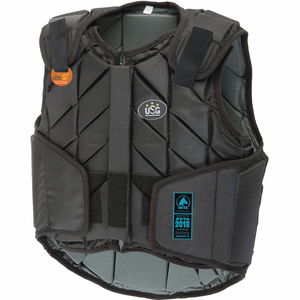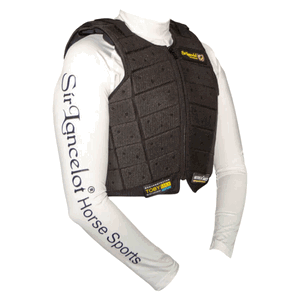Safety Vests for Horse Riding
(25)Frequently asked questions about Safety Vests
Safety in equestrian sports - a topic that should be of interest to everyone. In addition to the riding helmet, there are now many other products that offer the rider additional protection and safety. The airbag vest inflates during a fall and absorbs shocks to bones and organs. Sensitive parts of the body, such as the cervical spine, dorsal spine, rib cage and ribs are reliably protected. The airbag vest, which protects against collisions with its air-filled protector, is one of the most popular safety vests among professionals and amateurs. In addition, there are safety vests that protect a fall with their PVC or foam layer. They are very comfortable to wear and can sometimes be worn under sweaters or jackets. They are also breathable, flexible and often have an elastic strap to additionally fasten them.
It is mandatory to wear a safety vest when riding over cross-country obstacles or in eventing. For this purpose, a variant in accordance with European standard EN 13158, Level 3, is recommended. For best protection, it is advisable to wear the vest as close to the body as possible, preferably under a sweater or jacket. Care should be taken to ensure that it does not touch the rim of the saddle and equally does not exert any pressure on the cervical spine. Ideally, a safety vest should be tried on before buying to test whether it slips or pinches during movement.
A safety vest should be part of every rider's standard equipment. Many riders find it indispensable. Safety vests are often used in show jumping, eventing, cross-country riding and when breaking a young horse. They protect the chest and abdominal area, as well as the spine and back. It is important that it fits correctly and does not rest on the front or back of the saddle. The rider should not be restricted by wearing a safety vest, and should be able to move freely. For this reason, there are flexible, thin and light vests that are water-repellent and breathable. They give the rider reliable protection and cushion sensitive parts of the body.
As a rule, safety vests do not need to be replaced after a fall. However, depending on the severity of the impact, it is possible for vests to show damage afterwards. If they have open material spots or if individual components are completely destroyed, it is imperative to replace the vest. If a safety vest has been in use for several years, it should be noted that it can no longer provide full protection because the materials weaken over time. It is therefore recommended to buy a new vest. This reduces further potential danger and you are fully protected again the next time you fall.
A safety vest offers extensive protection in the upper body area. This means that the front area including the ribs, chest and partly also the shoulder area is protected. With a back protector, mainly the back parts of the body, such as the spine, are covered with a thicker material. The front is minimally neglected and is usually covered with a thin layer of fabric or a light chest protector. In the end, it is up to you to decide which type of protection suits you better and is more comfortable to wear.
The safety vest can only offer extensive protection if it fits snugly on the body. This means that the rider should be able to move freely and flexibly. If the vest fits too tightly, this prevents the rider from finding the optimal fit and the rein aids may be impaired as a result. In the worst case, a vest that is too tight can also cause pressure points or even pain. Some vests have variable fastening straps or further adjustment options, allowing the appropriate size to be selected. When choosing a size, it is also important to bear in mind that safety vests can expand when they heat up. After all, it is advisable to try out several vests and sizes in order to be able to decide which is most advantageous.
It is very important to follow the care instructions in the description or on the label of the safety vests. As a rule, they should not be washed in the washing machine, as this can destroy the inside. It should also be noted that they cannot be tumble dried. Coarse dirt can be removed with a brush or a damp cloth. Chemical detergents should be used with caution. It is possible that they will attack the material and the fabric of the safety vests and thus damage them.


































